Giant Isopods - Aliens Of The Deep
Continuing in the same spirit of my yesterday's post on trilobite beetles, today I want to introduce you to another prehistoric and scary looking creature that also bears a resemblance to the now extinct trilobites. Unlike the terrestrial trilobite beetles though, today's creature is a deep sea crustacean that is commonly known as the giant isopod.
Here's how it looks like:
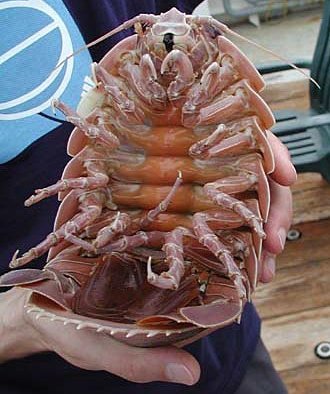
Bathynomus giganteus (credit)
And here's the same creature from another angle:
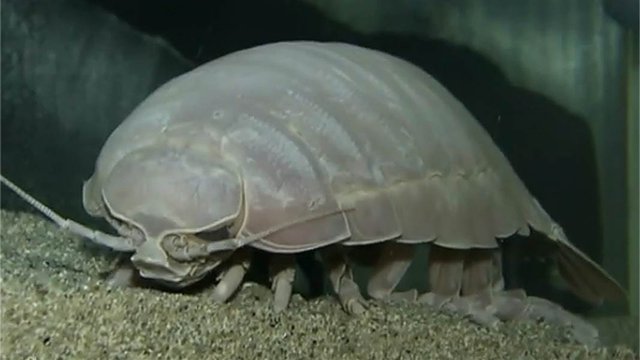 Giant Isopod (credit)
Giant Isopod (credit)
Looks creepy doesn't it? By the way, some of you may have noticed how it looks similar to the terrestrial common woodlouse (Oniscus asellus). That's not a coincidence as they are "cousins", being members of the same order, Isopoda. Like woodlouses, giant isopods can also curl into a ball to defend themselves.
Here's a photo for comparison:
 Common Woodouse (credit)
Common Woodouse (credit)
Now that you have an idea of how giant isopods look like, let's learn a bit more about them.
First, "giant isopod" is a term used for about 20 species of large isopods, all from the genus Bathynomus. All these species look quite similar and only have minor morphological differences.
The biggest and best known giant isopod species is Bathynomus giganteus. B. giganteus is also the first giant isopod that was described, by French zoologist Alphonse Milne-Edwards.
B. giganteus can reach a maximum weight of 1.7 kilo and a maximum length of 76 cm. Not impressed? Well you should be considering how most isopods are just a few cm long. For example, take the common woodlouse from before. On average, they are only 1.6 cm long!
Here's a video of a dead specimen to get a better idea of how big these critters get:
Why Are They So Big?
Well, giant isopods are a very good example of deep sea gigantism, which is the "tendency for species of invertebrates and other deep-sea dwelling animals to display a larger size than their shallower-water relatives". And to answer the question, why deep sea gigantism occurs is something we don't know yet but the proposed theories involve adaptation to scarcer food resources, greater pressure or colder temperature at depth. Some other examples of deep sea gigantism I love include the japanese spider crab, the colossal squid and my all time favorite, the Bigfin squid.
Where Can I Find One?
As mentioned before, giant isopods are deep sea creatures so chances are you will never encounter one. Although abundant in all major oceans, you'd have to go at least 170 meters deep to see one in its natural habitat.
To give you a generic idea, B. giganteus is usually found at depths ranging from 365 to 730 meters while other species can go much much deeper, with B. kensleyi holding the record, found at depths of up to 2,500 metres!
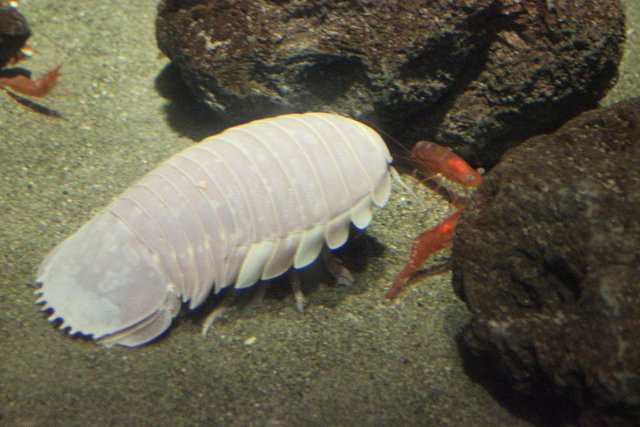 Giant isopod at Tokyo Sea Park (credit)
Giant isopod at Tokyo Sea Park (credit)
What Do They Eat?
They are carnivourous animals, mainly getting their food from scavenging the sea floor. Since food is rare down there, they are not picky eaters and eat anything dead that happens to fall, like whales, squids, fish or whatever. It's possible that they also eat live but slow-moving or immobile prey, like sea cucumbers, sponges, radiolarians, nematodes, and other zoobenthos.
Interestingly, one giant isopod was filmed attacking a larger dogfish shark in a deepwater trap! It latched on its face and ate a good chunk out of it and the shark later died as a result! The footage was aired during the 2015 episode of Shark Week called "Alien Sharks: Close Encounters" and after some googling, I believe this is the video that was aired, although the isopod is not clearly visible:
Since food is quite scarce, these creature have adapted to famine and can survive longs periods of time without eating anything. Out in the wild they can probably go for at least a couple of weeks or even months, while a specimen at Japan's Nagoya Public Aquarium reportedly went without food for...5 WHOLE YEARS!
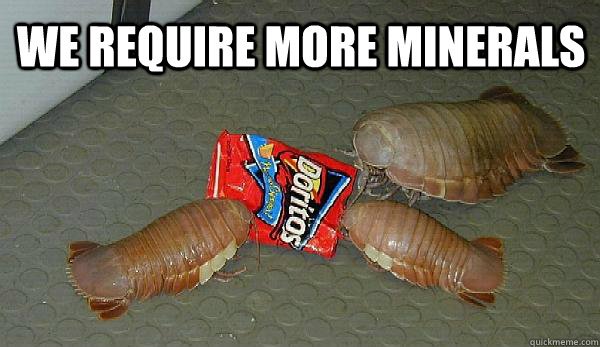
This meme is pure awesomeness. Too bad you probably won't get it! (credit)
What About Sex?
Giant isopods reproduce by eggs, which are believed to be the biggest among marine invertebrates, with a diameter of approximately 1.3 cm. The baby isopods that come out of them are fully formed and look like tiny miniatures of the adults (manca), lacking only the last pair of pereopods:
Due to their deep sea nature which makes observation difficult, we don't really know much about their reproductive patterns. although studies have shown a peak in reproductive capacity in the spring and winter months probably due to a shortage of food during the summer.
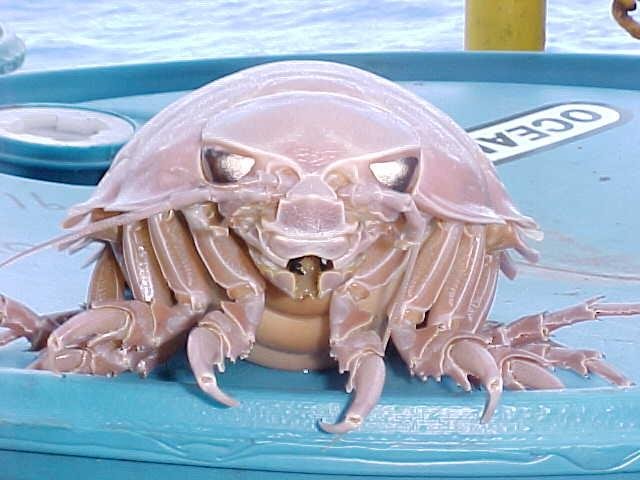
(credit)
The End
So, I think I have covered all the basics and interesting stuff you need to know about this alien-like creature with out getting into too much tiresome details! Feel free to click the various links provided inside the article if you want to learn more about this creature and the various species. Here's one last video showing a bunch of them having a snack:
 More Strange Animal Stuff
More Strange Animal Stuff
If you enjoyed reading this post I am sure you will love some of my previous work. Here are some of my latest posts:
- Clathrus archeri: Weird Alien-Like Eggs Hatch Into Weird Octopus Thing
- The Horseshoe Crab Named After Darth Vader
- Lobster with Pepsi Tattoo Fished In Canada !
- The Jesus Christ Lizard: A Lizard That Can "Walk" On Water
- It's a Scorpion...It's a Fly...It's a Scorpionfly! (Panorpa communis)
- Hagfish Have One Of The Weirdest And Coolest Defense Mechanisms
- Weird MRI Photos, 3-Eyed Beetles, Deep Sea Creatures And Other Cool Animal Stuff
- Can You Guess What Animal Has The Biggest Penis In The World?

I take it you are a Starcraft fan?? <3
more of a command & conquer (the old ones) fan, but yeah, star craft was good enough :D
I made a guess based on 'we require more minerals' =)
They just creep me out, because they look like cockroaches.
well, check out my latest post, even creepier :P
Eww.. time to train up some firebats
This creature looks kinda like an alien specie from ET. The last image there is looking like an angered alien :)
looks like it's getting ready to get your soul!
Lol. Soul not found :p
Τρώγεται; Πλάκα κάνω, ωραίο post...
λογικα ναι, υποθετω γεύση αστακού η κάτι τέτοιο :p
Hi! I featured this post in my article, Top 3 things that get attention on Steemit :)
https://steemit.com/steem/@dfrankle/top-3-things-that-get-attention-on-steemit
Check it out!
Without a doubt that in nature there are infinite varieties of strange animals and every day you can meet a new species and even more so if it is as rare as this one.
Postscript: very funny the photo of these creatures eating doritos :P
yeah, mother nature surprises me each and every day with the weird shit she comes up with!
It is absolutely incredible and very fascinating at the same time